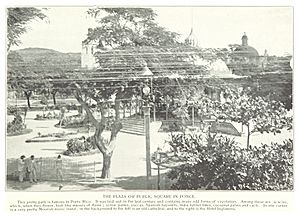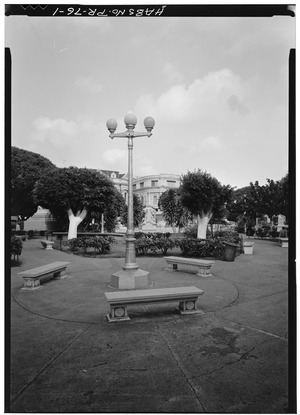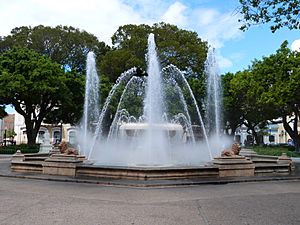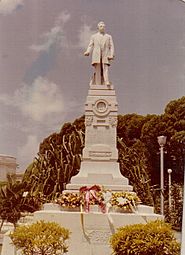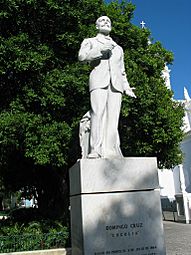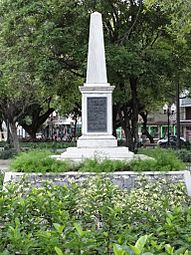Plaza Degetau facts for kids
Quick facts for kids Plaza Degetau |
|
|---|---|
| { Part of Plaza Las Delicias } Formerly, Plaza Real (1818) and Plaza Mayor (1874) |
|
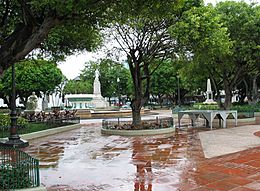
Plaza Degetau, one of two main plazas at Plaza Las Delicias
|
|
| Lua error in Module:Location_map at line 420: attempt to index field 'wikibase' (a nil value). | |
| Type | Plaza, urban park |
| Location | Ponce, Puerto Rico |
| Area | 6,400 square metres (69,000 sq ft) |
| Created | 1670 |
| Operated by | Autonomous Municipality of Ponce |
| Visitors | Over 200,000 |
| Status | Opened all year, 24 hours/day |
Plaza Degetau, also known as Plaza Federico Degetau, is a big public square in Ponce, Puerto Rico. It's part of a larger area called Plaza Las Delicias, which is the main town square in Ponce. Plaza Degetau is the southern part of Plaza Las Delicias. The other part, Plaza Muñoz Rivera, is to the north. This plaza is famous for its beautiful fountains and many statues.
You'll find the historic Parque de Bombas (old firehouse) and the Ponce Cathedral right next to it. Plaza Degetau is the heart of the historic area of Ponce. It's surrounded by important buildings like the Ponce City Hall and old banks. The plaza started way back in 1670 when Ponce was first settled. It's a top spot for tourists, with about 250,000 people visiting each year!
Contents
History of Plaza Degetau
In Spanish colonial times, the main town square, or plaza, was always the center of a town. In Ponce, a Catholic church was built in the middle of the plaza. This split the plaza into two parts. Plaza Degetau is the southern part, and Plaza Muñoz Rivera is the northern part. Plaza Degetau is about 6,400 square meters in size.
The history of Plaza Degetau goes back to 1670. That's when the first Catholic chapel was built in Ponce. Around 1840, Mayor Salvador de Vives planted trees to make the plaza look nicer. It got its first lights in 1864. The plaza you see today was designed by architect Francisco Porrata-Doria in 1914.
Long ago, Plaza Degetau also had a special open dining area. It was built in a Moorish style for an exhibition in 1882. This building was still there in 1898 when Americans arrived on the island. But it was taken down in 1914.
How the Plaza Got Its Name
Plaza Degetau had different names in the past. It was first called "Antigua Plaza Real" (Old Royal Plaza). Later, it was known as "Plaza Mayor" (Main Plaza). In the early 1900s, its name was officially changed to Plaza Federico Degetau. This was to honor Federico Degetau. He was the first person to represent Puerto Rico in the United States House of Representatives.
Cool Features of the Plaza
Plaza Degetau is probably the most famous of the two plazas. It's the one you'll see in most pictures of Ponce.
The Lions Fountain
At the center of Plaza Degetau is the famous Fuente de los Leones (Lions Fountain). This large, round fountain has a low wall made of marble and granite. The wall is shaped like an octagon. One corner of the octagon points towards the historic Ponce City Hall. The fountain also has four lion statues and colorful lights that shine on the water. The lion statues are placed on every other corner of the octagon.
In 1878, a monument to the Spanish Constitution of 1812 stood where the Lions Fountain is now. This monument was removed later. In 1882, an "Arab kiosk" was built there for the Ponce Fair. This kiosk was taken down in 1914. The fountain you see today was bought in 1939 from the 1939 New York World's Fair. When it was first put in, it had statues of baby angels. But in the early 1940s, these angels were replaced with the lions you see now. The lions were sculpted in 1940 by Victor Cott from Juana Díaz, Puerto Rico. The fountain was fixed up and made new in 1993. Its base was made bigger, and a new computer-controlled lighting system was added.
Juan Morel Campos Statue
This plaza also has a statue of the famous local composer Juan Morel Campos. This statue was made in Italy by sculptor Luiggi Tomassi.
Other Statues and Monuments
There's also an obelisk in the plaza. It honors the firefighters who fought the big "El Polvorín" fire. This obelisk was put up in 1948. This was just in time for the 50th anniversary of that terrible fire.
On the northwest side of the plaza, you'll find a statue called Blind Justice. It shows a woman in a long dress with her eyes covered. She holds a sword that rests on the ground. Two children sit happily by her feet. One child is hugging the sword, and the other is playing with an orange tree branch.
Another statue, called Maternity, is also in the plaza. It shows a woman sitting with two small children on her lap. The children lean against her chest. These two statues, Blind Justice and Maternity, were designed by Victor Cott. He also sculpted the four lions at the Lions Fountain.
A third statue, La Labradora, used to be in Plaza Degetau. It was on the southeast side. But today, it's in Parque Graciela Rivera. La Labradora and another sculpture called El Cuerno de la Abundancia (The Horn of Abundance) were moved out of the plaza in the late 1940s. This made space for the obelisk honoring the "El Polvorín" firefighters (1948) and the statue of Juan Morel Campos (around 1950). El Cuerno de la Abundancia was moved to another part of Ponce. Sadly, it was damaged and lost. These changes happened when Andrés Grillasca Salas was mayor.
Where is Plaza Degetau?
Plaza Degetau is bordered by the Our Lady of Guadalupe Cathedral and the historic Parque de Bombas firehouse to the north. To the south, it's bordered by Plaza Degetau street. Union street is to the west, and Marina street is to the east.
The plaza is surrounded by hotels, the Ponce City Hall, two historic banks, a famous ice cream shop called "King's Ice Cream", and many shops and cafes.
The plaza has wide sidewalks with mosaic tiles. It has beautiful flower gardens, neatly trimmed bushes, and Indian laurel trees. You'll also see old-fashioned lamp posts from the late 1800s and many marble benches. The Lions Fountain is here, which is known as "one of the most beautiful fountains in Puerto Rico." It's made of marble and bronze. During the day, the plaza is busy with students, shoppers, and tourists. After the sun sets, you can often find live bands playing music for families.
Images for kids


